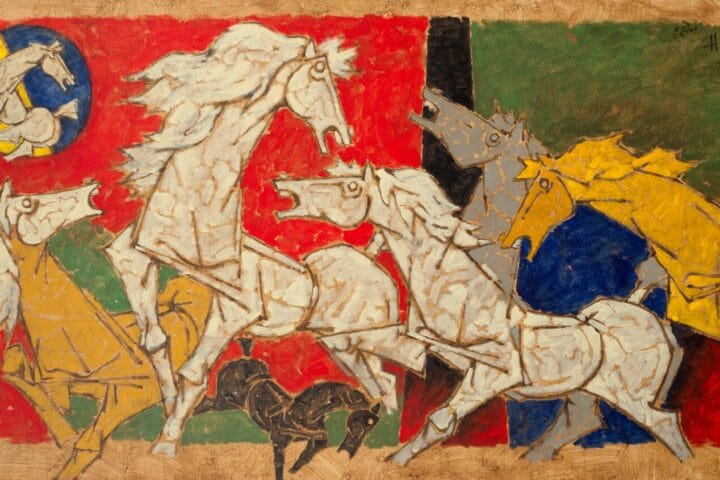“The dream world and the real world are the same.”
Remedios Varo
London – Members of the Surrealist group would often play a game. It involved participants drawing or writing on a piece of paper before folding it and passing it on to the next person, who would add their addition without seeing the former’s work, and then, in turn, pass it on to the next player. It was called Cadavre Exquis (or Exquisite Corpse), and it was a practice that would progress into a form of collaborative painting, with one canvas featuring contributions from multiple artists. A rare example, Composition surréaliste (tableau collaboratif) by the Spanish artist Remedios Varo (1908-1963) with possible additions by Tenerife-born Óscar Domínguez (1906-1957) and Catalan artist Esteban Francés (1913-1976), is to feature in Bonhams’ Impressionist and Modern Art sale on Thursday 20 April in New Bond Street, London. The work has an estimate of £50,000 – 70,000.
Composition Surréaliste (tableau collaboratif) is believed to have been painted when the artists were residing in Barcelona. Many of the group’s works from this time have been lost, due in part to the Spanish Civil War, as well as their free circulation among other artists by post and itinerant friends – a mode of distribution Varo and her group actively encouraged, keen for the recognition and support of their Surrealist peers.
Though the only legible signature on the work is the ‘O. Domínguez. 35’, an inscription reading ‘Esteban F 36’ to the upper right, and one further inscription reading ‘Francés’ to the lower left, have been removed. Varo’s metaphorical ‘signature’ can be discerned in the precise execution of her husband Gerardo Lizarraga’s decapitated head in the bottom corner. One possible reading is that the painting was started by Francés, but then Domínguez or Varo (or both) reworked the composition, thereby erasing his signatures. Similarly, Francés could have revisited the painting and saw that his contributions had been so changed that he deemed it necessary to remove any sign of his authorship – or potentially the twice erasure of his signature could allude to a significant emotional upheaval between Francés, Domínguez and Varo.
Ruth Woodbridge, Head of Impressionist and Modern Art at Bonhams, commented: “Within the Surrealist group, turbulent personal relationships often spilled over onto canvases and Composition Surréaliste (tableau collaboratif) embodies something of the complex love affair between Varo and fellow Surrealists, Domínguez and Francés. Varo stated that “the dream world and the real world are the same,” and the work can be seen as a collective autobiography and dreamlike exploration of the trio’s innermost thoughts, passions, and fears.
“The decapitated head of Varo’s husband could signify Varo’s evolution away from the needs she once prescribed to the relationship, whilst the implicit violence could represent the looming backdrop of the Spanish Civil War. Not long after the work was completed, Varo fled Barcelona for Paris with Francés and her new lover, Benjamin Péret, to whom she had been introduced by Domínguez. Often seen only as muses, women within the surrealist movement have often been overlooked yet Varo’s voice and desire for freedom can clearly be felt within this work, and so it is wonderful to be able to firmly place her as a key creator in this important Surrealist piece.”
In 1938, during a Surrealist gathering in Domínguez’ Montparnasse studio, Domínguez and Francés came to blows over Varo’s affections. Victor Brauner – a Romanian artist with whom Varo would later live – restrained Francés’ arms. Unfortunately, in so doing Brauner was hit by a glass thrown by Domínguez, which ripped the artist’s eye from its socket. Varo believed wholeheartedly in premonitions, and seven years prior to his injury, Brauner had completed a self-portrait with a gaping hole in place of his right eye. Domínguez had, around seven years prior to the brawl, completed a self-portrait in which his hand was mutilated, his arm veins severed. Twenty-seven years later, after an unsuccessful exhibition, he was discovered in the bathtub of his Montparnasse studio, having slit his wrists. Composition Surréaliste (tableau collaboratif) was perhaps for the trio, a group premonition of the turbulent times ahead.
Other highlights include:
- Salvador Dalí (1904-1989), Rideau-chevelure semi-humain séparé par une fermeture éclair (Hairy half-human curtains separated by a zipper). Estimate: £80,000 – £120,000.
- Marie Laurencin (1883-1956), Portrait de Mia Bergmann avec chien. Estimate: £70,000 – £100,000.
- Georges Rouault (1871-1958), Bord de mer, paysage animé (Souvenir de Bretagne). Estimate: £70,000 – £100,000.
- Karl Hofer (1878-1955), Circusleute. Estimate: £70,000 – £100,000.
- Giorgio De Chirico (1888-1978), Vita silente. Estimate: £40,000 – £60,000.
- Salvador Dalí (1904-1989), Visage féminin Pour L’hologramme ‘Submarine Fisherman’. Estimate: £7,000 – £10,000.

Visage féminin pour l’hologramme ‘Submarine Fisherman’, is part of Dalí’s second holographic work, Submarine Fisherman, executed under the guidance of Selwyn Lissack. It consisted of a holographic installation mixing different media: first, a holographic plate of a diver was isolated in a metallic box with a laser light. This was then incorporated within another larger box which had a separate source of lighting shining onto a transparency of Pablo Picasso’s masterpiece, Les Demoiselles d’Avignon. This second box projected the image around the hologram – contained within the first box – like stained glass. Finally, Dalí painted an oil portrait of a Catalan girl on a glass plate – the present work – which he superimposed over the holographic plate. The multi-layered result showed the portrait of the Catalan girl projected over the hologram of a diver in the sea, superimposed on the reproduction of Les Demoiselles d’Avignon. Visage féminin pour l’hologramme ‘Submarine Fisherman’ is an extremely rare piece, as Dalí only ever conceived of six other holograms.











